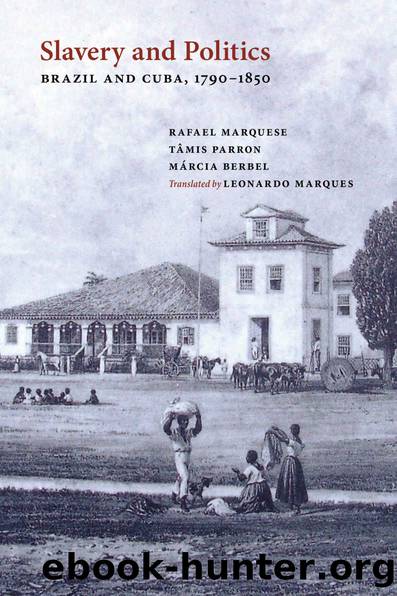Slavery and Politics: Brazil and Cuba, 1790-1850 by Rafael Marquese & Tâmis Parron & Márcia Berbel

Author:Rafael Marquese & Tâmis Parron & Márcia Berbel [Marquese, Rafael]
Language: eng
Format: epub
Publisher: University of New Mexico Press
Published: 2016-06-15T03:00:00+00:00
CHAPTER 4
The Politics of Slavery in the
Constitutional Empires, 1837â1850
THE PROSLAVERY COMPACTS established in the second half of the 1830s led to an effective association between capital and politics in the Brazilian and Spanish Empires. Between 1823 and 1835, the Cuban treasury accumulated around 5 million pesos every year, of which 10 percent was sent to Madrid, first as remisiones de fondos and later as sobrantes de Ultramar. With the growth of colonial production and the fiscal reforms implemented by the peninsular government during the following decade, the money sent to Madrid rose by 600 percent per year (from 500,000 to 3 million pesos). Part of these resources financed the participation of the constitutional monarchy in the Carlist wars.
The situation in the Empire of Brazil shared many similarities with the Spanish context. With the growing number of regional revolts (Farroupilha, Sabinada, Balaiada, and Cabanagem), the government increased public expenditures from 12,000 contos in 1834 to 24,000 contos in 1839, of which 54 percent was spent on defense. However, a comparable growth in imperial revenue, which went from 14,000 contos in 1834 to 24,000 contos in 1844, was spurred by the growth of agricultural exports. The expansion of slavery and the contraband slave trade significantly contributed to stabilizing the constitutional regimes of the Brazilian and Spanish Empires.1
The intensification of the transatlantic slave trade in turn led to the rapid deterioration of relations with Britain. Led by the Agency Committee, the abolitionist movement pressed the British government to abolish apprenticeship in 1838 instead of 1840 and launched an international campaign to abolish slavery in other countries. In the words of the abolitionist newspaper Reporter, the âFrenchmen, the Dutchmen, the Danes, the Spaniards, the Brazilians, and the North Americans felt the influence of slavery in the British colonies. . . . They consider us conquerors; they can foresee their destiny.â Besides the domestic motivations, the internationalization of the abolitionist movement was also the result of the successful reopening of the slave trade to Brazil. The yearly mean of disembarked slaves in all the Americas tripled because of the numbers of disembarkations in Brazil, which rose from twenty-nine thousand between 1831 and 1834 to seventy-seven thousand between 1836 and 1839. Thus, two associations were created in Britain at the turn of the decade to fight the odious commerce: the Society for the Extinction of the Slave Trade and for the Civilization of Africa of Thomas Fowell Buxton, and the British and Foreign Antislavery Society of Joseph Sturge. While the former believed in a gradual replacement of the illegal commerce in slaves with the trade of legal goods, the latter called for the abolition of slavery in all countries as the only way to suppress the traffic as a whole. A fundamental step in this campaign was taken in 1840 when the first World Antislavery Convention convened in London, which received delegations from many countries, especially France and the United States.2 An efficient Atlantic network of militants and informants gradually emerged in the main slaveholding regions
Download
This site does not store any files on its server. We only index and link to content provided by other sites. Please contact the content providers to delete copyright contents if any and email us, we'll remove relevant links or contents immediately.
The Dawn of Everything by David Graeber & David Wengrow(1654)
The Bomber Mafia by Malcolm Gladwell(1584)
Facing the Mountain by Daniel James Brown(1504)
Submerged Prehistory by Benjamin Jonathan; & Clive Bonsall & Catriona Pickard & Anders Fischer(1420)
Wandering in Strange Lands by Morgan Jerkins(1374)
Tip Top by Bill James(1351)
Driving While Brown: Sheriff Joe Arpaio Versus the Latino Resistance by Terry Greene Sterling & Jude Joffe-Block(1339)
Evil Geniuses: The Unmaking of America: A Recent History by Kurt Andersen(1320)
Red Roulette : An Insider's Story of Wealth, Power, Corruption, and Vengeance in Today's China (9781982156176) by Shum Desmond(1315)
The Way of Fire and Ice: The Living Tradition of Norse Paganism by Ryan Smith(1305)
American Kompromat by Craig Unger(1271)
It Was All a Lie by Stuart Stevens;(1265)
F*cking History by The Captain(1254)
American Dreams by Unknown(1238)
Evil Geniuses by Kurt Andersen(1225)
Treasure Islands: Tax Havens and the Men who Stole the World by Nicholas Shaxson(1222)
White House Inc. by Dan Alexander(1181)
The First Conspiracy by Brad Meltzer & Josh Mensch(1140)
The Fifteen Biggest Lies about the Economy: And Everything Else the Right Doesn't Want You to Know about Taxes, Jobs, and Corporate America by Joshua Holland(1092)
